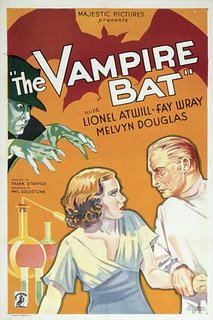
Release Date: 1933
Director: Frank R Strayer
Contains Spoilers.
Something is rotten in the town of Kleinschloss. Citizens are being killed, their bloodless bodies have marks at the neck that look as though the fangs of some animal have been sunk deep into the jugular.
Sounds like the typical start of a vampire movie, but there is little typical about this absolute gem of a film. Yet, the townsfolk of Kleinschloss would agree with your first instincts as they are all convinced that their town is being attacked by a vampire. All, that is, except Karl Brettschnieder (Melvyn Douglas), the local constable. He refuses to believe that supernatural creatures are attacking the people he is sworn to protect and, you know what, he is absolutely right.
The Vampire Bat does not contain a single vampire, and yet it is most definitely a vampire movie. The murders are committed by Dr. Otto von Niemann (Lionel Atwell). Placing his hapless assistant (Robert Frazer) under the influence of hypnosis, and with the use of some form of psychic link, von Niemann causes him to go into the town and abduct people so that the Doctor can drain their blood for his deranged experiments.
Yet it is the hysteria of the townsfolk that makes this movie a vampire movie. The blame for the killings is soon heaped upon Herman Gleib (Dwight Frye), a simpleminded man who has made pets of the bats in his lodgings.
Gleib’s portrayal by Frye is superb. Frye himself is no stranger to the vampire genre; he played Renfield to Lugosi’s Dracula in the seminal “Dracula” (1931) and also played the vampire’s mad assistant, Zolarr, in “Dead Men Walk” (1943). As an aside, it is worth noting that in the film “The Night Flier” (1997), by Stephen King, the vampire goes by the name Dwight Renfield – a definite nod to Frye in his most famous vampire genre role.
The townsfolk eventually hunt down Gleib causing him to fall from a ledge in some nearby caves and, though we don’t see it, the townsfolk make sure of things by climbing down and staking the innocent through the heart. In these scenes, Strayer captures the essence of the fear that will have caused many of the vampire panics in earlier centuries and the scenes are a precursor to the sublime “Isle of the Dead” (1945) – another vampire movie sans vampire.
With a death occurring after the murder of Gleib, Karl gains the evidence to go after von Niemann.
The film also stars Fay Wray as Ruth Betin, Karl’s love interest, in the same year that “King Kong” launched her into the stardom stratosphere.
This film deserves a strong 8 out of 10 and, whilst it is available on DVD, it is also in the public domain, so you can download it from The Archive.
The IMDB page for the film is here.
On DVD @ Amazon US
On DVD @ Amazon UK
Tuesday, March 07, 2006
The Vampire Bat - review
Posted by
Taliesin_ttlg
at
7:46 AM
![]()
Labels: belief in vampires
Subscribe to:
Post Comments (Atom)
















4 comments:
The ending marred this otherwise fine film for me.
I also reviewed this movie:
Mark's Review of The Vampire Bat
You have a great page here! I found it via Mystery of the Haunted Vampire.
Thanks Mark,
I've read your review and agree that the ending is weak - but the strength of the rest of the film carries it.
Many thanks for the comment
Andy, your summary reminds me of MARK OF THE VAMPIRE, where a similar trick is played by the murderer.
Prodosh this and Rakter Swad use vampirism to hide a crime (and both have an innocent blamed as a vampire and killed), the difference in Mark of the Vampire (and, of course, the lost London After Midnight) is that they use vampirism to catch a killer. There are similar mechanisms of course in the deceit.
Post a Comment